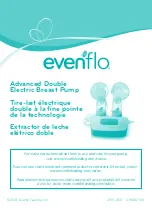
6
I experience
pain when I
express
If you feel any discomfort, you may
need a different size breast cushion.
Visit
www.lansinoh.co.uk,
call +44 (0) 113 205 4201 in the UK,
or contact your country distributor.
I do not feel
any suction
or the
suction is
very low
If it feels like the suction has
decreased, try the following:
•
While pump is on, remove the
tubing from the diaphragm cap
and place a finger over the tubing
connector. If you feel suction, the
pump is operating properly, but the
Breastmilk Expression Set may not
be correctly assembled or the white
valve may be damaged. If you don’t
feel any suction, try unplugging the
pump, wait a few seconds, and plug
it back into the electrical outlet.
•
Make sure the Breastmilk Expression
Set has been properly assembled.
Check the assembly information in
Section 2.3, page 4.
•
Confirm that all connections
(especially the tubing) are secure.
Make sure the
breast cushion forms
a complete seal around the breast.
•
Inspect the white valve for a tear or
pinhole. This component is critical
to achieving proper suction. Replace
the white valve with one of the spare
valves provided with the product.
I accidentally
washed the
tubing
If you notice any condensation
or anything that may be mould,
discard the tubing and contact our
customer service team to purchase a
replacement.
3. BREASTMILK STORAGE GUIDELINES
Breastmilk Storage and Thawing Guidelines for Healthy
Term Babies
Check with your healthcare professional or an
International Board Certified Lactation Consultant for
specific storage instructions. When freezing breastmilk,
store in the back of the freezer. Do not store breastmilk in
the freezer door as the temperature can fluctuate when
the door is opened and closed.
Before storing, date all breastmilk and use the oldest
breastmilk first.
Milk Storage Guidelines, Full term infant
WHERE
TEMPERATURE
TIME
ACTION
At Room
Temperature
60‑80°F
(19‑26°C)
4 hours (ideal)
up to 6 hours
(acceptable)
Contents
should be
covered and
kept as cool
as possible;
covering the
container
with a damp
towel may
keep milk
cooler
Insulated
Cooler Bag
5‑39°F
(‑15 ‑ 4°C)
24 hours
Keep ice
packs in
constant
contact
with milk
containers;
limit
opening
cooler bag
In a
Refrigerator
<39°F
(<4°C)
4 days (ideal)
up to 5 days
(acceptable)
Store milk
in the back
of the main
body of the
refrigerator
Freezer
0°F
(‑18°C)
3 months (ideal)
up to 6 months
(acceptable)
Store milk
away from
sides and
toward the
back of
the freezer
where
temperature
is most
constant
Deep Freezer
‑4°F
(‑20°C)
6 months (ideal)
up to 12 months
(acceptable)
Source: La Leche League International 2017
These breastmilk storage guidelines are a recommendation.
Contact your health professional or consult your country’s
national guidelines for further information.
Thawing Breastmilk
Thaw frozen milk in the refrigerator or place the
containers under cool running water, gradually warming
the water until the milk is thawed. Thawed milk can be
kept in a refrigerator for up to 24 hours.
DO NOT refreeze milk once it is thawed.
Gently swirl thawed milk before feeding to mix the layers
that have separated. Breastmilk is not homogenized and
the “cream” will rise to the top. Breastmilk can vary in
colour and consistency depending upon the time of the
day that the milk was expressed, what you have eaten, and
the age of the baby at the time of pumping. For further
advice, please contact your health care professional.

















